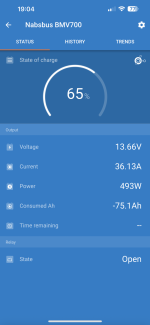merl
Full Member
- Posts
- 2,952
- Likes
- 6,705
I notice that the Sterling appear to use the input current rather than the output. Which is deceptive but I guess not many users will have a DC clamp meter so it hardly ever gets picked up. I'd be pretty pi55ed if I got 42A from a 60A unit but that's small print for ya.I have the same B2B and likewise get a maximum of 42 amps output.
I spoke to Sterling about this and they fudged the answer by stating that the theoretical output is 60 amps but after allowing for conversion losses, cabling losses etc the real world figure is significantly lower. As we have both found.
Thus far, and I've been using the B2B for quite a few years, and touching wood... I've not had any overheating issues.
Have you ever checked the input current? It wouldn't surprise me if they were over egging that too because 60A input with just 42A output would mean either a large difference in voltage or a low efficiency unit or false claims (or a combination of some/ all of them) .


